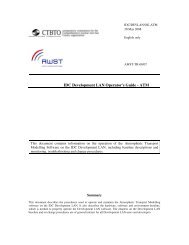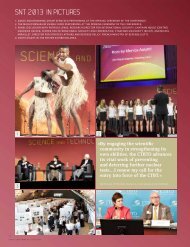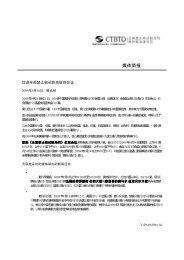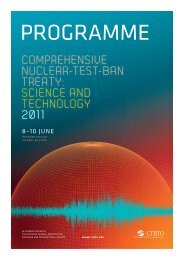CTBTO Spectrum - December 2002 Issue 1 - Comprehensive ...
CTBTO Spectrum - December 2002 Issue 1 - Comprehensive ...
CTBTO Spectrum - December 2002 Issue 1 - Comprehensive ...
You also want an ePaper? Increase the reach of your titles
YUMPU automatically turns print PDFs into web optimized ePapers that Google loves.
In the spotlightSergei A. Ordzhonikidzecontinued from page 7Organizations or between InternationalOrganizations. The Commission has alarge number of bilateral agreements andarrangements with States hostinginternational monitoring facilities for theCTBT.International Monitoring System(IMS) facility agreements andarrangements are foreseen in the Treatyand are based on models adopted by theCommission to regulate theestablishment and provisional operationand maintenance of the facilities. Todate, the Executive Secretary has signed22 such agreements and arrangements onbehalf of the organization, of which 15have entered into effect and two areapplied provisionally.Negotiating IMS facilityagreements can take time. Early on itwas realized that the Commission'sprogramme of work could not wait forthem to be finalized. The practice thusevolved for host States to authorize thenecessary work by means of interimexchanges of letters, pending conclusionof the formal facility agreement. Thishas been a successful approach and legalarrangements in the form of IMS facilityagreements, or exchanges of letters, nowgovern the Commission's activities at309 of the 337 monitoring facilities in 76of the 90 host States.Mr. Ordzhonikidze,a Russian nationaland career diplomat,was appointedDirector-General ofthe United NationsOffice at Geneva inMarch <strong>2002</strong>. Healso serves as theSecretary-Generalof the Conference on Disarmament.Mr. Ordzhonikidze joined theSoviet diplomatic service in 1969 andhas held several positions at thePermanent Mission of his country to theUnited Nations in New York, includingDeputy Permanent Representative. InMoscow he served as Deputy Chief ofthe International Legal Department ofthe Foreign Ministry and Director ofInternational Organizations of theForeign Ministry. In 1999, Mr.Ordzhonikidze was appointed DeputyMinister of Foreign Affairs.Q: The <strong>Comprehensive</strong> Nuclear Test-Ban-Treaty (CTBT) was negotiated at theConference on Disarmament in Genevabetween 1993 and 1996.Where do you as the Secretary-General of this Conference place theCTBT in the overall historic context of theConference on Disarmament?A: In the nuclear context, I place theCTBT in the logical, and I hopehistorical, chain that leads fromuncontrolled nuclear proliferation tomultilaterally agreed and verifiedelimination of all nuclear weapons. Theconclusion of the CTBT in theConference on Disarmament marked thecompletion of an important step in thisprocess that essentially started with thenegotiation of the Nuclear Non-Proliferation Treaty (NPT) in one of theConference on Disarmament’spredecessor bodies.More broadly, I see the CTBT,together with the Biological WeaponsConvention and the Chemical WeaponsConvention, as a link in the fence thatwill ultimately keep out all weapons ofmass destruction. The job of theConference on Disarmament is tocontinue building this fence.Q: In the Final Declaration of theConference on Facilitating the Entry intoForce of the CTBT adopted in New Yorkon 13 November 2001, 109 ratifying andsignatory States affirmed “…that theconduct of nuclear-weapon testexplosions or any other nuclearexplosion constitutes a serious threat toglobal efforts towards nucleardisarmament and non-proliferation.”In your view, what effect will theentry into force of the CTBT have onglobal non-proliferation efforts and thedisarmament process?“The entry into force of the CTBTwould provide an immediate boostto both non-proliferation efforts andthe whole disarmament process.”PAGE 8<strong>CTBTO</strong> SPECTRUM 1 | WWW.<strong>CTBTO</strong>.ORG
















